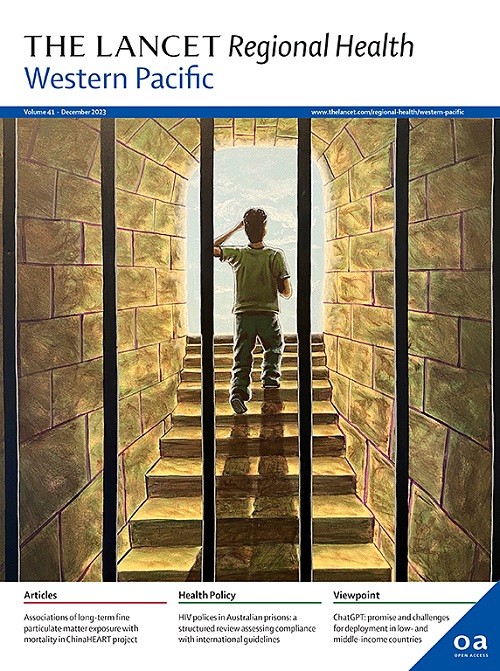12789名成人感染欧米克隆后一年的健康结果:一项基于社区的横断面研究
IF 7.6
1区 医学
Q1 HEALTH CARE SCIENCES & SERVICES
引用次数: 0
摘要
描述长冠状病毒病的模式和影响对于应对这一全球卫生挑战至关重要。本研究旨在调查原发性Omicron感染一年后长时间COVID的患病率,并表征持续长时间COVID和完全康复的参与者之间长期健康后果的差异。方法采用分层多阶段随机抽样方法,于2023年12月至2024年3月在北京中日友好医院和北京市16个行政区开展以社区为基础的横断面研究,招募2022年12月至2023年1月感染欧米克隆病毒的12789名参与者纳入最终分析。其中,376名持续长冠和229名无长冠的参与者进行了进一步的身体检查。主要观察指标为感染后1年长时间COVID的流行率。次要结局包括肌力、运动能力、健康相关生活质量(HRQoL)、心理健康、工作状态、实验室测试和检查。在12,789名参与者中(媒体[IQR]年龄,48.4[37.3至61.4]岁;女性7817例(61.1%),其中995例(7.8%)在一年内出现长时间感染,651例(5.1%)出现持续症状。疲劳(598/995[60.1%])和运动后不适(367/995[36.9%])是最常见的症状。脑雾在一年内的分辨率最低,为4.2%。长冠肺炎的几率随着再感染而增加(1次再感染的优势比为2.592 [95% CI: 2.188 ~ 3.061];两个或更多:6.171[3.227到11.557];所有p <;0.001)。持续长时间COVID的参与者肌肉力量明显降低(上肢:26.9±12.4 vs 29.1±14.5 Kg;下肢:40.0 [27.0 ~ 62.0]vs. 43.0 [28.0 ~ 59.0] s),运动能力和HRQoL较差,实验室检查结果与未长冠患者相比有显著差异。肺功能异常比例(FEV1 % vs. 80%: 13.0% vs. 2.0%;DLco %pred<80%: 32.7%对19.9%)和肺部影像学异常(23.5%对13.6%)。长期COVID的巨大健康负担和Omicron感染后神经系统症状的进展需要密切监测。利用专业问卷调查和开发可靠的诊断工具是提高长冠肺炎诊断和治疗水平的必要条件。北京呼吸道传染病研究中心(BJRID2024-012)、中国医学科学院医学科学创新基金(2022- im2 - cov19 -005/CIFMS 2021- im2 -1-048)、国家自然科学基金(82241056/82200114/82200009)、新基石科学基金资助。本文章由计算机程序翻译,如有差异,请以英文原文为准。
Health outcomes one year after Omicron infection among 12,789 adults: a community-based cross-sectional study
Background
Characterizing the paradigm and impact of long COVID is crucial for addressing this worldwide health challenge. This study aimed to investigate the prevalence of long COVID one year after primary Omicron infection and characterize differences in long-term health consequence between participants with persistent long COVID and those who fully recovered.
Methods
This a community-based cross-sectional study conducted from December 2023 to March 2024 at the China-Japan Friendship Hospital and 16 administrative districts in Beijing. 12,789 participants infected with Omicron between December 2022 and January 2023 were recruited through stratified multistage random sampling and included in the final analysis. Of them, 376 participants with persistent long COVID and 229 without long COVID were matched for further physical examinations. The primary outcome was the prevalence of long COVID one year after infection. Secondary outcomes included muscle strength, exercise capacity, health-related quality of life (HRQoL), mental health, work status, laboratory tests, and examinations.
Findings
Among 12,789 participants (media [IQR] age, 48.4 [37.3 to 61.4] years; 7817 females [61.1%]), 995 of them (7.8%) experienced long COVID within one year, with 651 (5.1%) having persistent symptoms. Fatigue (598/995 [60.1%]) and post-exertional malaise (367/995 [36.9%]) were the most common symptoms. Brain fog had the lowest resolution proportion as 4.2% within one year. The odds of long COVID increased with reinfections (odds ratios for one reinfection 2.592 [95% CI: 2.188 to 3.061]; two or more: 6.171 [3.227 to 11.557]; all p < 0.001). Participants with persistent long COVID had markedly lower muscle strength (upper-limb: 26.9 ± 12.4 vs. 29.1 ± 14.5 Kg; lower-limb: 40.0 [27.0 to 62.0] vs. 43.0 [28.0 to 59.0] s), worse exercise capacity and poorer HRQoL, and meaningful difference in laboratory tests results compared to those without long COVID. They also exhibited significantly higher proportions of abnormal lung function (FEV1 %pred<80%: 13.0% vs. 2.0%; DLco %pred<80%: 32.7% vs. 19.9%) and lung imaging abnormalities (23.5% vs. 13.6%).
Interpretation
The considerable health burden of long COVID and the progression of neurological symptoms following Omicron infection warrant close monitoring. Utilizing professional questionnaires and developing reliable diagnostic tools are necessary for improving diagnosis and treatment of long COVID.
Funding
This work was supported by Beijing Research Center for Respiratory Infectious Diseases (BJRID2024-012), Chinese Academy of Medical Sciences Innovation Fund for Medical Sciences (2022-I2M-CoV19-005/CIFMS 2021-I2M-1-048), the National Natural Science Foundation of China (82241056/82200114/82200009), the New Cornerstone Science Foundation.
求助全文
通过发布文献求助,成功后即可免费获取论文全文。
去求助
来源期刊

The Lancet Regional Health: Western Pacific
Medicine-Pediatrics, Perinatology and Child Health
CiteScore
8.80
自引率
2.80%
发文量
305
审稿时长
11 weeks
期刊介绍:
The Lancet Regional Health – Western Pacific, a gold open access journal, is an integral part of The Lancet's global initiative advocating for healthcare quality and access worldwide. It aims to advance clinical practice and health policy in the Western Pacific region, contributing to enhanced health outcomes. The journal publishes high-quality original research shedding light on clinical practice and health policy in the region. It also includes reviews, commentaries, and opinion pieces covering diverse regional health topics, such as infectious diseases, non-communicable diseases, child and adolescent health, maternal and reproductive health, aging health, mental health, the health workforce and systems, and health policy.
 求助内容:
求助内容: 应助结果提醒方式:
应助结果提醒方式:


